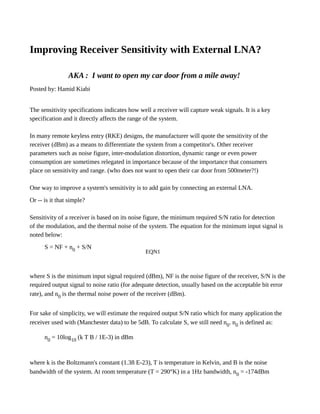
LNA Sensitivity for Receivers
- 1. Improving Receiver Sensitivity with External LNA? AKA : I want to open my car door from a mile away! Posted by: Hamid Kiabi The sensitivity specifications indicates how well a receiver will capture weak signals. It is a key specification and it directly affects the range of the system. In many remote keyless entry (RKE) designs, the manufacturer will quote the sensitivity of the receiver (dBm) as a means to differentiate the system from a competitor's. Other receiver parameters such as noise figure, inter-modulation distortion, dynamic range or even power consumption are sometimes relegated in importance because of the importance that consumers place on sensitivity and range. (who does not want to open their car door from 500meter?!) One way to improve a system's sensitivity is to add gain by connecting an external LNA. Or -- is it that simple? Sensitivity of a receiver is based on its noise figure, the minimum required S/N ratio for detection of the modulation, and the thermal noise of the system. The equation for the minimum input signal is noted below: S = NF + n0 + S/N EQN1 where S is the minimum input signal required (dBm), NF is the noise figure of the receiver, S/N is the required output signal to noise ratio (for adequate detection, usually based on the acceptable bit error rate), and n0 is the thermal noise power of the receiver (dBm). For sake of simplicity, we will estimate the required output S/N ratio which for many application the receiver used with (Manchester data) to be 5dB. To calculate S, we still need n0. n0 is defined as: n0 = 10log10 (k T B / 1E-3) in dBm where k is the Boltzmann's constant (1.38 E-23), T is temperature in Kelvin, and B is the noise bandwidth of the system. At room temperature (T = 290°K) in a 1Hz bandwidth, n0 = -174dBm
- 2. (commonly expressed as = -174dBm/Hz). For a 300kHz IF bandwidth, n0 is calculated to be –119dBm. Let's assume the sensitivity of our system to be –109dBm. Using EQN1, we can determine the NF of our receiver to be 5dB. Recalling the relationship between noise figure (NF) and noise factor (F): (NF)db = 10logF and F = 10(NFdb/10) The noise factor is thus F = 3.162. To find the noise factor of several cascaded two port devices, we use the following equation: FTotal = F1 + (F2 - 1) / G1 + (F3 - 1) / (G1 × G2) + ... EQN2 So if we add an external LNA to the input of our system, we can use EQN2 to to calculate our new noise factor. Assuming an LNA that has a NF = 1dB (F1 = 1.26) and a gain of 15dB (G1 = 31.62), and since the noise factor of our original system is F2 = 3.162, then Ftotal = 1.327 or 1.23dB. Next using EQN1, the new sensitivity is now: S = 1.23 - 119 + 5 = -112.77db Therefore, adding the external LNA improved our sensitivity by 3.77dB only, which, depending on the requirements, may or may not be enough. However, noise figure is only part of the picture. The receiver has a system IIP3 of -34dBm. This is due to the fact that the mixer IIP3 is -18dBm while the internal LNA gain is 16dB for a system IIP3 of -34dBm. Adding the LNA externally will reduce the system IIP3 from -34dBm to -49dBm (LNA gain is 15dB) which means that the signal-handling capability of our system has been reduced. In other words, even though the sensitivity was improved by almost 4dB, at the expense of the dynamic range of the system (IIP3) reduction by 15dB. The discussion in this short article is applicable to all kind of receivers, from a simple remote key less entry (RKE), to Cell phones. By the way if you wondering, YES A company did make such receiver, it did not made to production. The receiver was so prone to jamming that was practically useless, except in those rare occasions operating within a fairly noise free (RF) environment, then you actually could open your car door almost from 460 meter, that is almost half a kilometer!